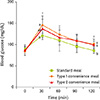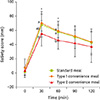1. Pae M. Dietary habits and perception toward food additives according to the frequency of consumption of convenience food at convenience stores among university students in Cheongju. Korean J Community Nutr. 2016; 21:140–151.

2. Lee KA, Cho EJ, Yoon HS. A study on consumption of convenience foods of university students by residing types in Changwon and Masan area. J Korean Diet Assoc. 2010; 16:279–290.
3. Moon SJ, Yoon HJ, Kim JH, Lee YJ. A study on the perception and consumption pattern of convenience foods by Korean college students. Korean J Diet Cult. 1998; 13:227–239.
4. Kim SJ, Bu SY, Choi MK. Preference and the frequency of processed food intake according to the type of residence of college students in Korea. Korean J Community Nutr. 2015; 20:188–196.

5. Einarson TR, Machado M, Henk Hemels ME. Blood glucose and subsequent cardiovascular disease: update of a meta-analysis. Curr Med Res Opin. 2011; 27:2155–2163.

6. Gerstein HC, Santaguida P, Raina P, Morrison KM, Balion C, Hunt D, Yazdi H, Booker L. Annual incidence and relative risk of diabetes in people with various categories of dysglycemia: a systematic overview and meta-analysis of prospective studies. Diabetes Res Clin Pract. 2007; 78:305–312.

7. McKeown NM, Meigs JB, Liu S, Saltzman E, Wilson PW, Jacques PF. Carbohydrate nutrition, insulin resistance, and the prevalence of the metabolic syndrome in the Framingham Offspring Cohort. Diabetes Care. 2004; 27:538–546.

8. Zhou XH, Qiao Q, Zethelius B, Pyörälä K, Söderberg S, Pajak A, Stehouwer CD, Heine RJ, Jousilahti P, Ruotolo G, Nilsson PM, Calori G, Tuomilehto J; DECODE Study Group. Diabetes, prediabetes and cancer mortality. Diabetologia. 2010; 53:1867–1876.

9. Jung EY, Suh HJ, Hong YH, Lee IY, Kim DG, Kim MO, Chang UJ. Effects of glycemic index for boiled white rice and boiled white rice mixed with grains on food consumption and satiety rate. J Korean Diet Assoc. 2009; 15:179–187.
10. Josic J, Olsson AT, Wickeberg J, Lindstedt S, Hlebowicz J. Does green tea affect postprandial glucose, insulin and satiety in healthy subjects: a randomized controlled trial. Nutr J. 2010; 9:63.

11. Lim YS, Park HR, Han GJ. Comparison of preference for convenience and dietary attitude in college students by sex in Seoul and Kyunggi-do area. J Korean Diet Assoc. 2005; 11:11–20.
12. Roberts SB. High-glycemic index foods, hunger, and obesity: is there a connection? Nutr Rev. 2000; 58:163–169.

13. Flint A, Gregersen NT, Gluud LL, Møller BK, Raben A, Tetens I, Verdich C, Astrup A. Associations between postprandial insulin and blood glucose responses, appetite sensations and energy intake in normal weight and overweight individuals: a meta-analysis of test meal studies. Br J Nutr. 2007; 98:17–25.

14. Rolls BJ. Carbohydrates, fats, and satiety. Am J Clin Nutr. 1995; 61:960S–967S.

15. Slavin J, Green H. Dietary fibre and satiety. Nutr Bull. 2007; 32:32–42.








 PDF
PDF ePub
ePub Citation
Citation Print
Print



 XML Download
XML Download